Control valves are critical components in regulating fluid flow and pressure in various industrial applications. At the heart of many control valves is the bonnet, a key component that plays a vital role in ensuring the safe and efficient operation of the valve. This article delves into the significance of the bonnet in control valves, its various types, and best practices for maintenance and troubleshooting to enhance valve longevity and performance.
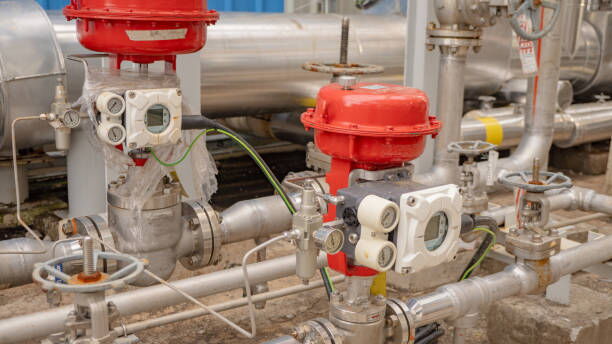
A bonnet in a control valve serves as a pressure-retaining component that covers the valve body opening. It connects the valve body to the actuator, preventing leakage of the process fluid while also providing a mechanical barrier. The bonnet must withstand the high pressures and corrosive effects of the media flowing through the valve, making its design and construction essential for maintaining the integrity of the valve and the safety of the overall system.
In control valves, the bonnet's function extends beyond just sealing the valve body. It helps manage the flow of fluid, supports the valve stem and packing, and can incorporate components like gaskets, seals, and even heating or cooling jackets depending on the application. Given its critical role, selecting the correct bonnet type for specific temperature, pressure, and fluid conditions is key to ensuring reliable valve performance.
The bonnet in a control valve is located between the actuator and the valve body. It functions as a protective cover and provides a sealing mechanism that helps prevent leakage of media from the valve. Due to the diverse range of applications and operating conditions control valves are used in, bonnets come in several different forms, each designed to meet specific operational needs. Let’s explore the five most common bonnet types used in control valves.
Standard bonnets are the most common type used in control valves for regular temperature and pressure applications. They are typically designed to handle moderate pressure and temperature conditions and are ideal for applications that do not involve extreme temperatures or hazardous fluids.
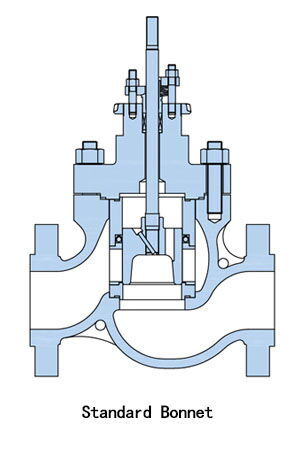
Recommended Temperature Range: -20°C to +230°C
Use: Best suited for general-purpose applications where temperature fluctuations are not extreme.
Applications: Standard bonnets are used in industries like water treatment, heating systems, and general fluid control.
Extension bonnets are specifically designed to protect valve stem packing from the effects of extreme temperatures. They are equipped with a long extension tube that keeps the actuator and packing at a safe distance from high or low temperature media, ensuring that the packing material remains in optimal condition.
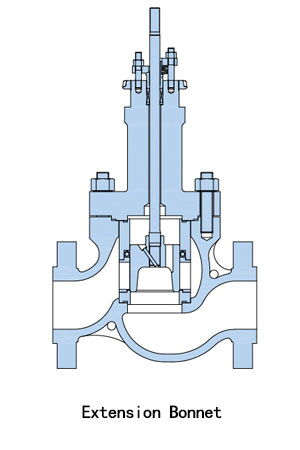
Recommended Temperature Range: -60°C to +450°C
Use: These are used in high or low-temperature applications where the temperature of the process media exceeds or drops below the safe operating limits of standard valve components.
Applications: Common in chemical processing, oil & gas, and cryogenic applications.
Bellows bonnets are often used in situations where the process fluid is toxic, volatile, radioactive, or highly expensive. These bonnets incorporate a bellows seal to prevent leakage of hazardous fluids into the environment, offering a robust containment solution.
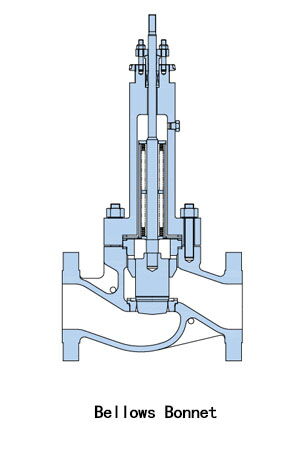
Use: Ideal for handling toxic, hazardous, or valuable fluids that require an additional layer of containment to prevent leaks.
Applications: Chemical manufacturing, pharmaceutical industries, nuclear power, and other industries dealing with hazardous materials.
Jacket bonnets are specifically designed for applications involving fluids that have high viscosity or tend to solidify at room temperature. The jacket provides a heating or cooling mechanism that maintains the fluid at the optimal temperature, preventing solidification and ensuring consistent flow.
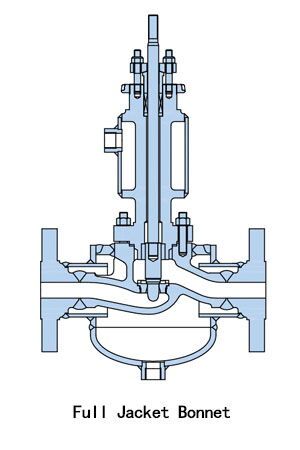
Use: Common in applications involving thick, viscous fluids like oils, syrups, or molten materials.
Applications: Food processing, petrochemical industries, and manufacturing where temperature control is critical.
Pressure seal bonnets are designed to withstand high-pressure applications by utilizing the pressure of the system itself to create a seal. These bonnets are typically used in high-pressure steam, water, and gas systems. The pressure acting on the bonnet ensures a tight seal between the bonnet and valve body.
Use: Common in high-pressure applications, particularly in steam boilers, power plants, and other industrial systems operating under high pressure.
Applications: Power generation, steam systems, and high-pressure fluid systems.
The bonnet in a control valve is crucial to its performance, and selecting the correct type based on the application conditions can result in increased safety, efficiency, and durability. Here are a few key benefits of correctly selecting and maintaining control valve bonnets:
A properly sealed bonnet helps prevent the leakage of hazardous fluids, protecting the environment and workers.
Different bonnet types are designed to protect valve components from extreme temperatures, corrosive media, and high pressures.
By choosing the right bonnet for the application, the valve can operate efficiently for extended periods, reducing the need for frequent maintenance and repairs.
With the correct bonnet in place, the risks of accidents caused by leakage or valve failure are minimized.
Regular maintenance and prompt troubleshooting of valve bonnets are essential for maintaining optimal performance. Here are some tips to ensure the longevity and reliability of your valve bonnet:
Frequent inspections are necessary to detect early signs of wear or damage to the bonnet. Look for signs of corrosion, cracks, or other forms of degradation, particularly in harsh environments where the bonnet is exposed to extreme temperatures or corrosive media.
Leakage is a common issue with valve bonnets. It can often be traced back to a deteriorated or improperly seated gasket. In such cases, replacing or reseating the gasket can resolve the issue. For bolted bonnets, checking the tightness of bolts or studs is critical, as temperature and pressure fluctuations can cause them to loosen.
For bolted bonnets, it’s essential to check the tightness of the bolts or studs regularly. As pressure and temperature conditions fluctuate, bolts may loosen over time, which can compromise the seal. Follow a systematic tightening pattern to ensure even pressure distribution across the bonnet seal.
In environments prone to corrosion, it’s important to inspect the bonnet and body for signs of material degradation. Using corrosion-resistant materials or protective coatings on the bonnet can significantly extend its service life, especially in harsh chemical or marine environments.
For welded bonnets, routine inspection of the welds is essential. Ultrasonic or radiographic testing can detect unseen flaws in the welds that could compromise the seal or integrity of the valve. Regular checks can help prevent failure before it becomes a serious issue.
For pressure seal bonnets, ensuring the correct alignment during assembly is vital. Misalignment can lead to operational failures under high-pressure conditions, causing potential system breakdowns and safety hazards.
Monitor the operating conditions regularly to ensure that the bonnet is capable of withstanding the extreme temperatures or pressures it may be subjected to. Ensuring that the bonnet’s specifications align with the system’s requirements can prevent premature failure.
The bonnet in a control valve is much more than a protective cover. It plays a critical role in ensuring that the valve operates safely and efficiently under various conditions, including extreme temperatures, high pressures, and corrosive environments. Understanding the different types of bonnets available, their applications, and the importance of maintenance will allow industries to choose the most suitable bonnet for their needs, extending the service life of the valve and enhancing its performance.
By following proper maintenance and troubleshooting protocols, operators can ensure the continued reliability and functionality of valve bonnets, reducing downtime and preventing costly repairs. In high-pressure systems or processes involving hazardous materials, a well-maintained valve bonnet can be the difference between smooth operations and catastrophic failure.
